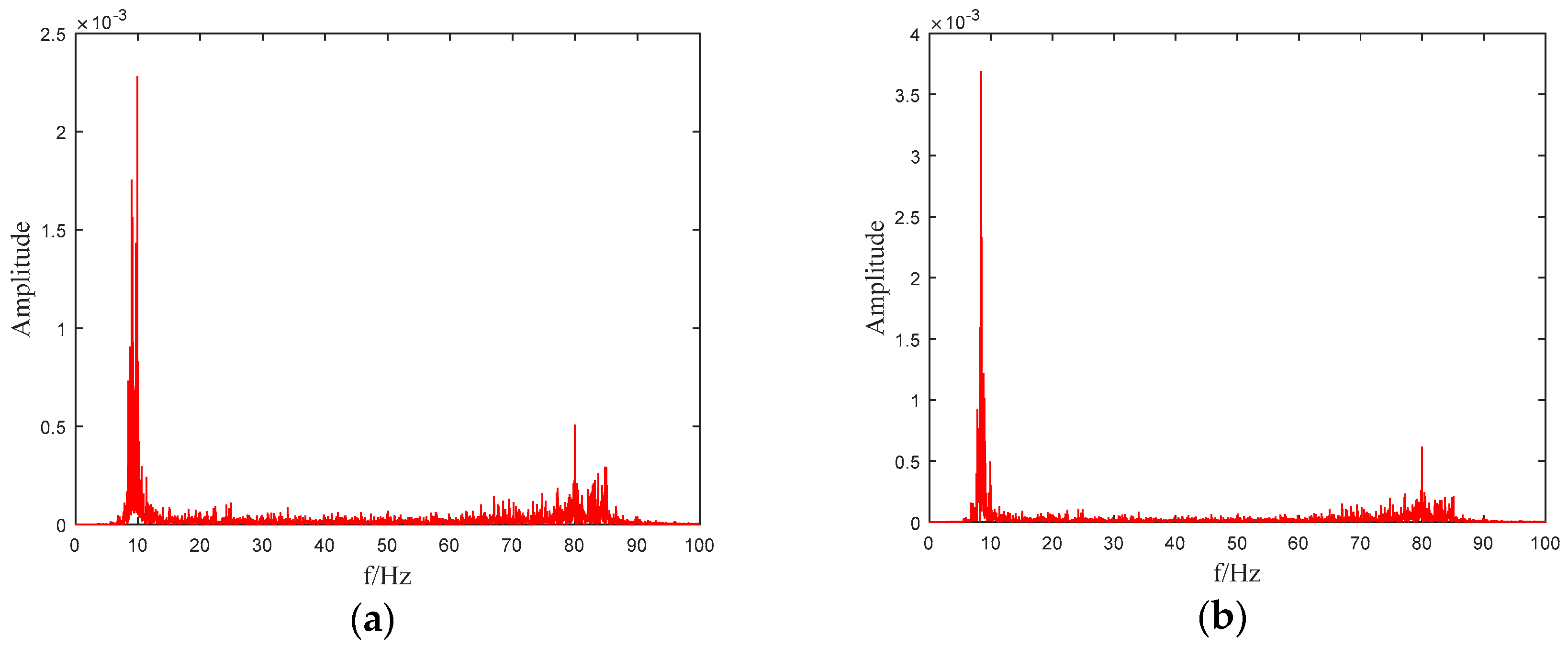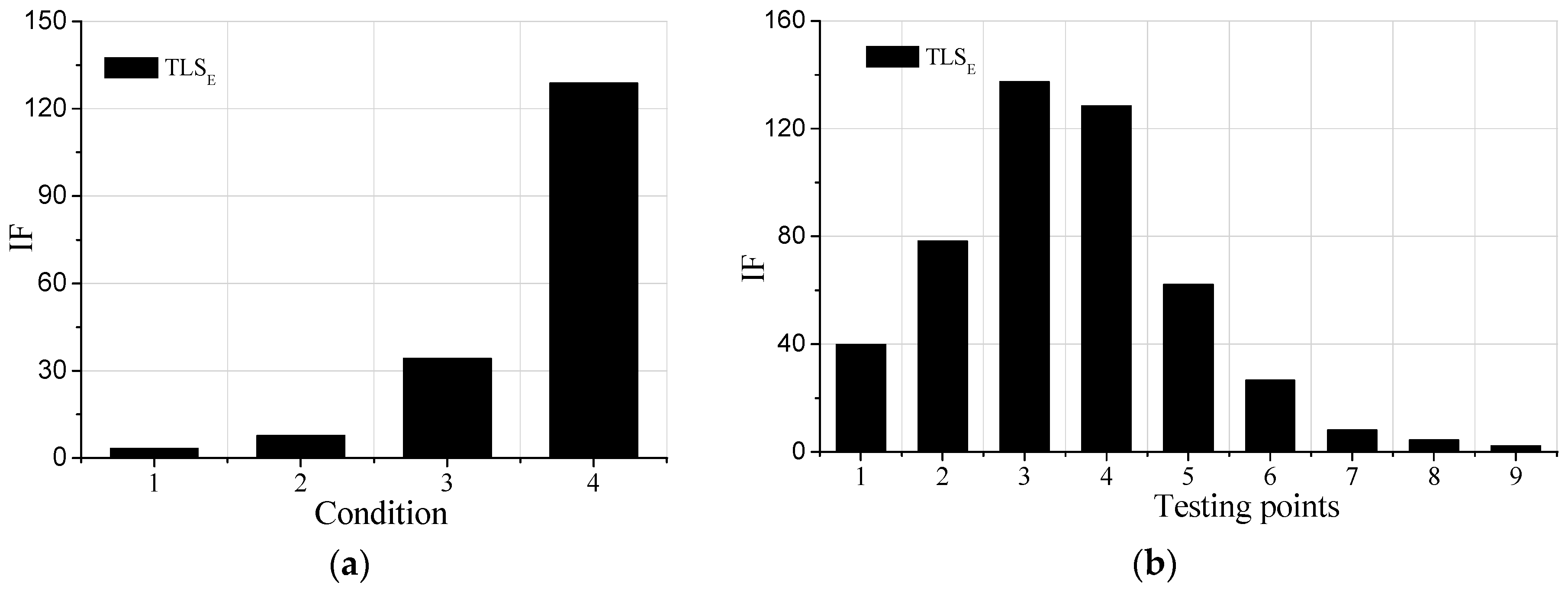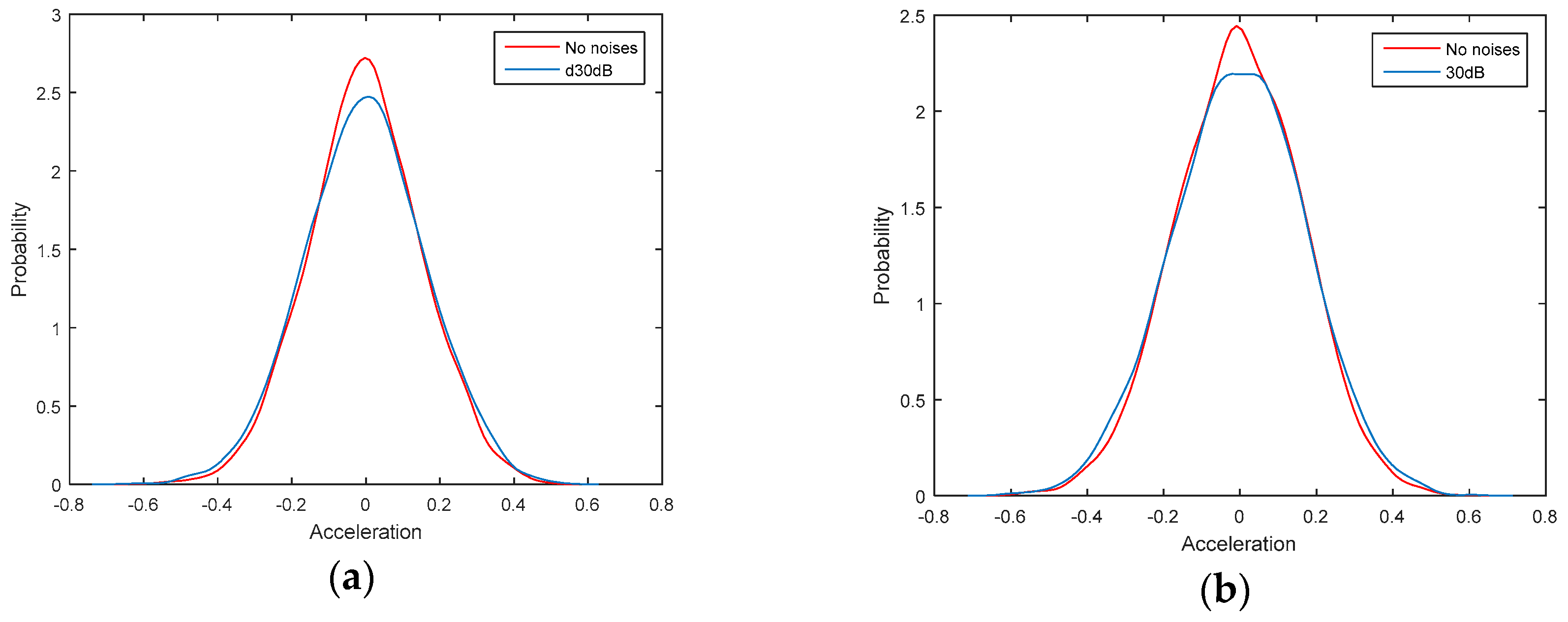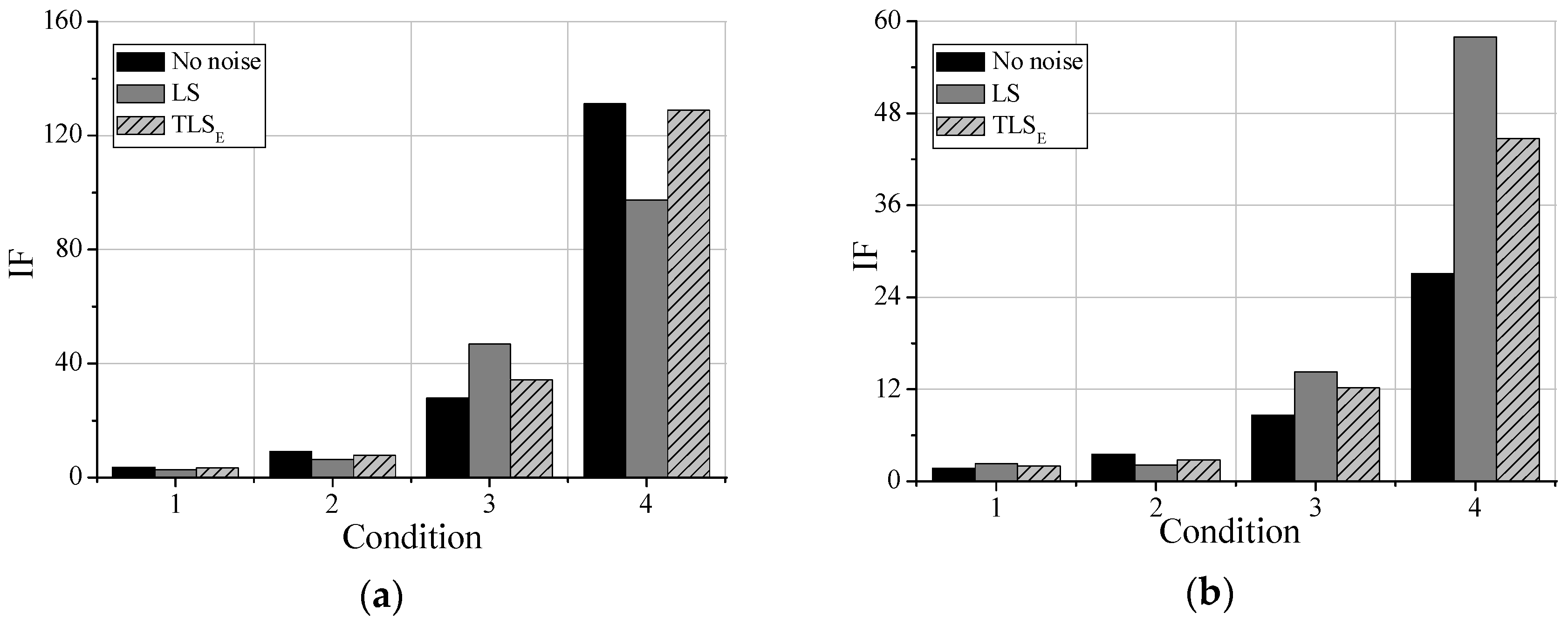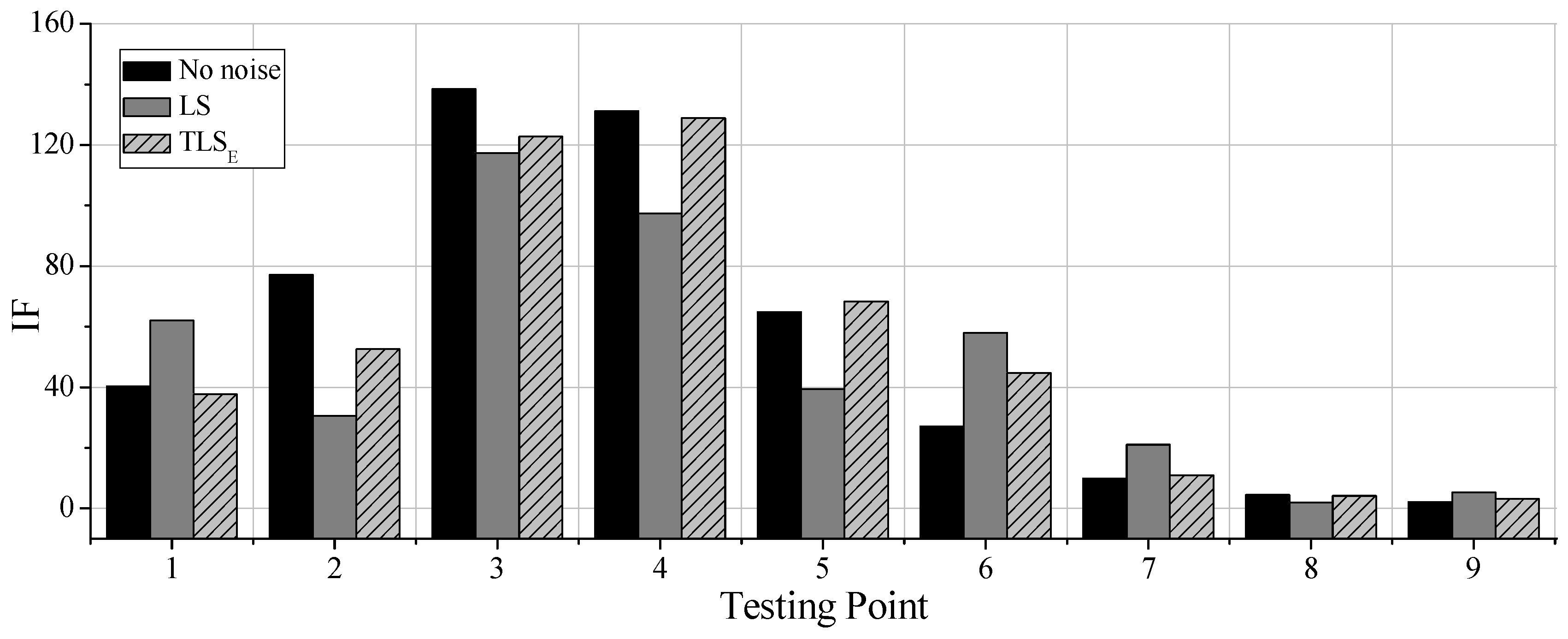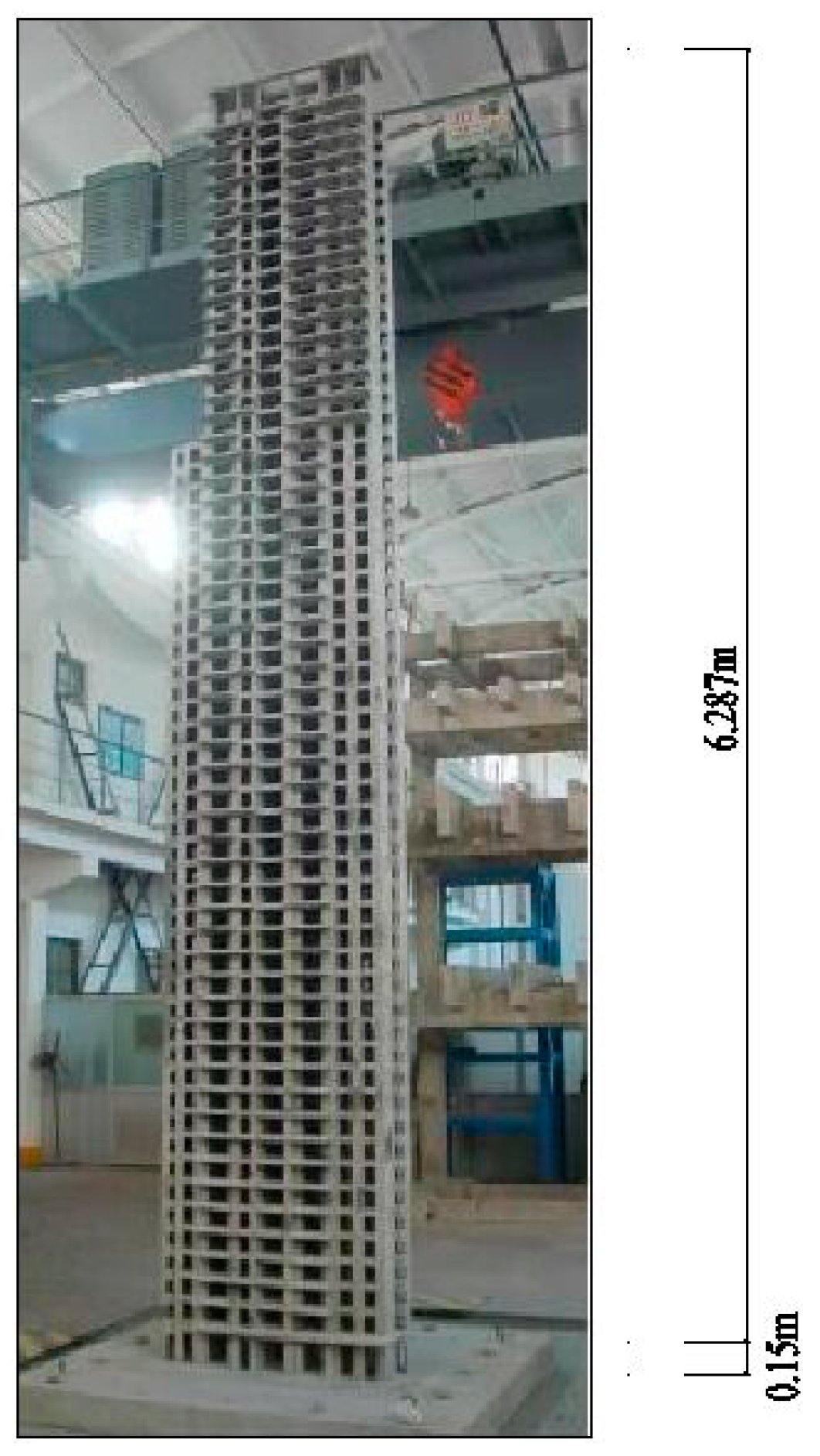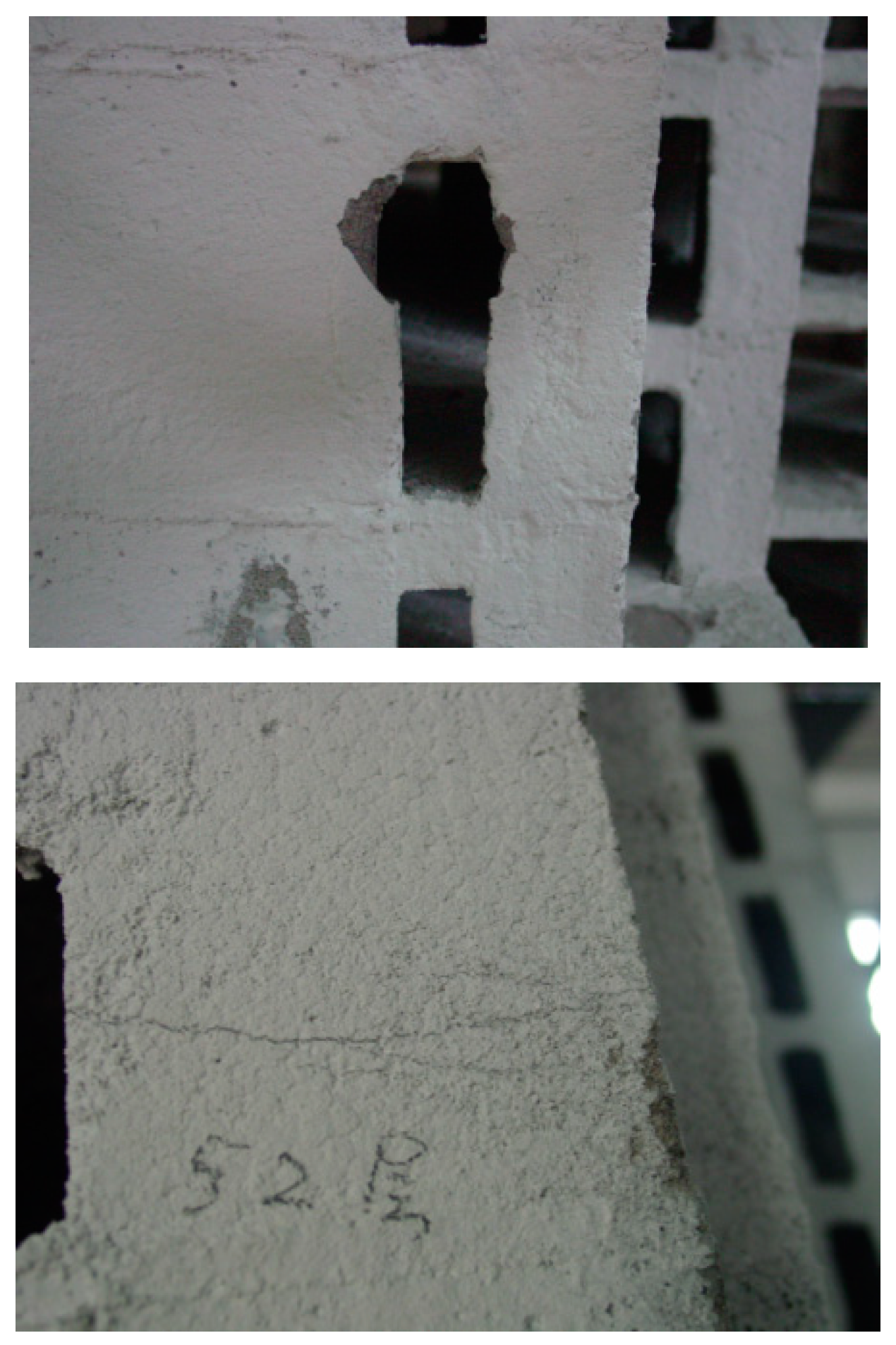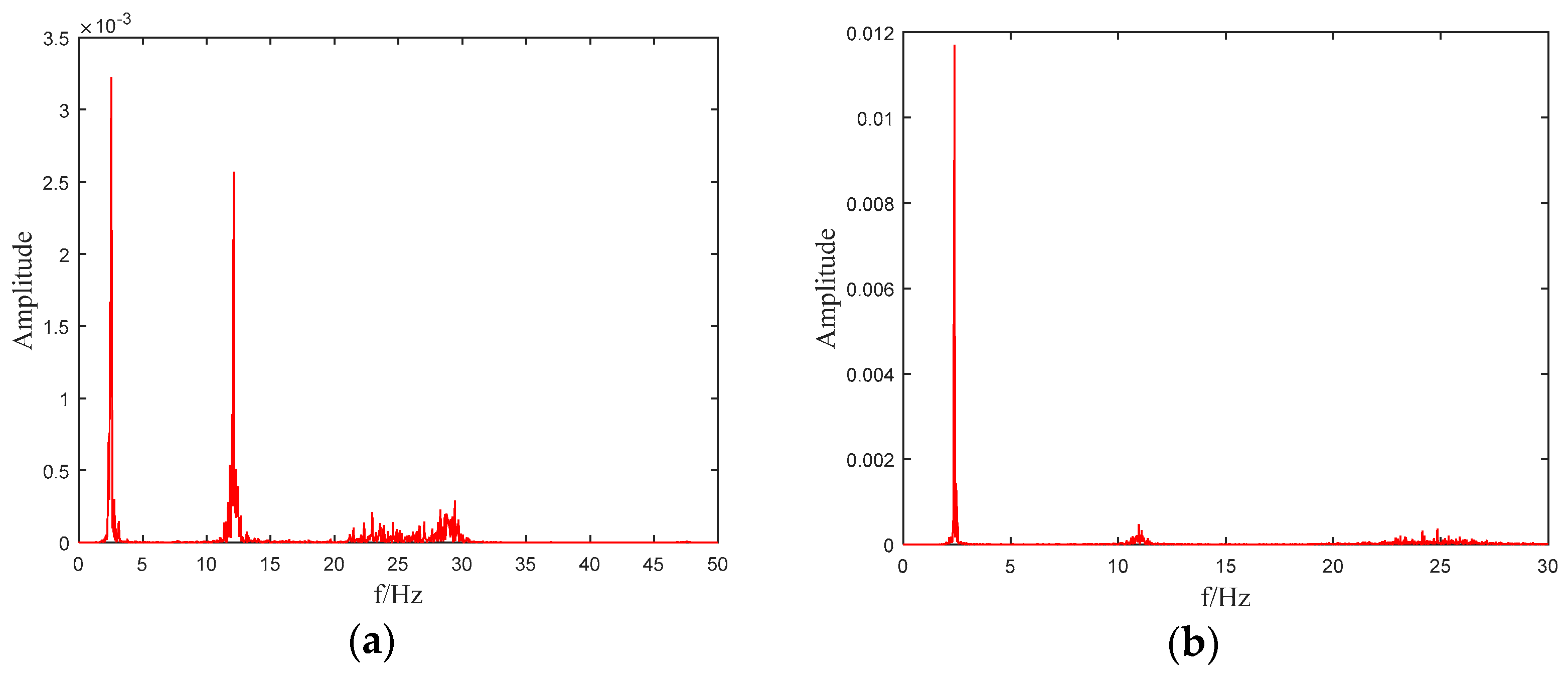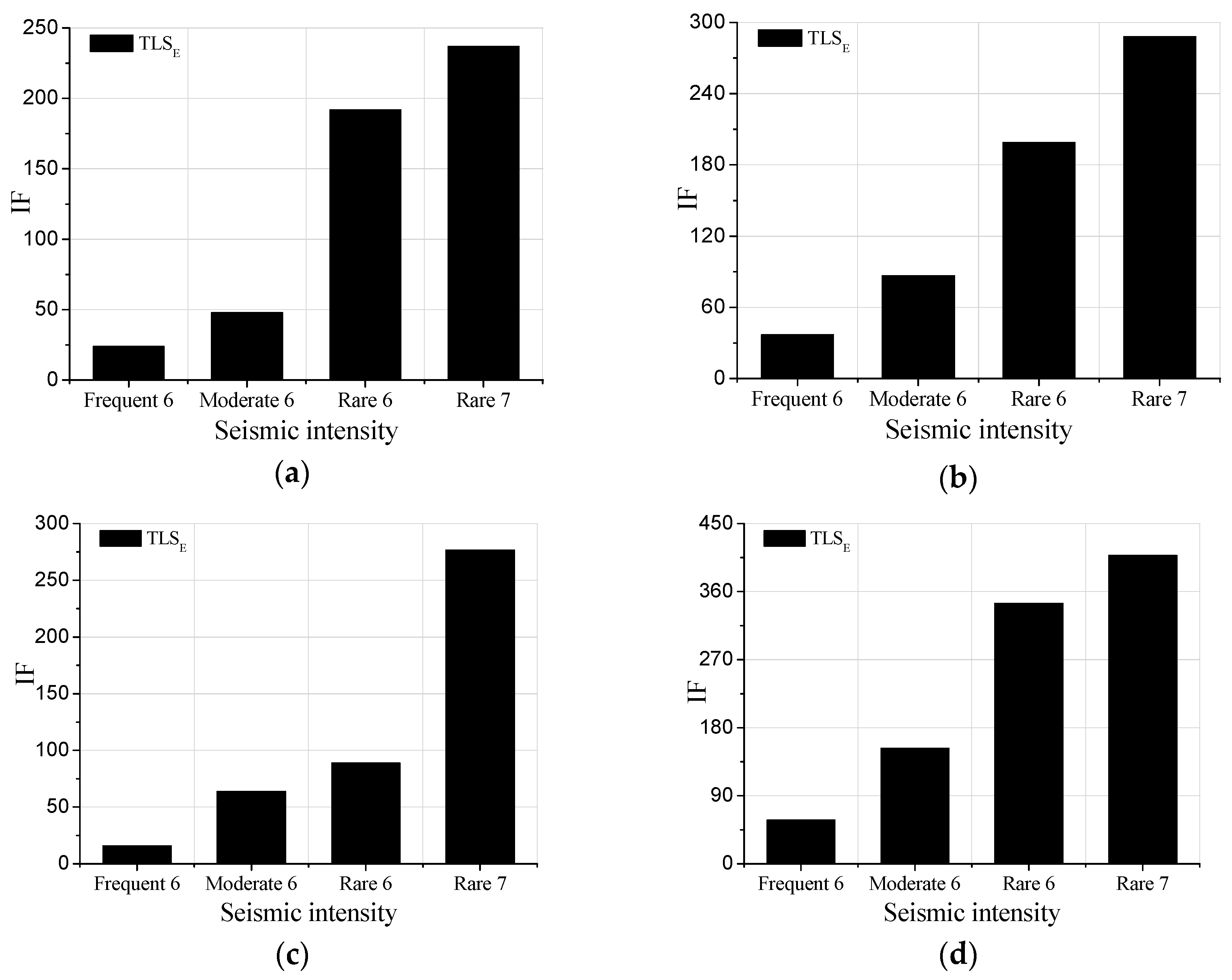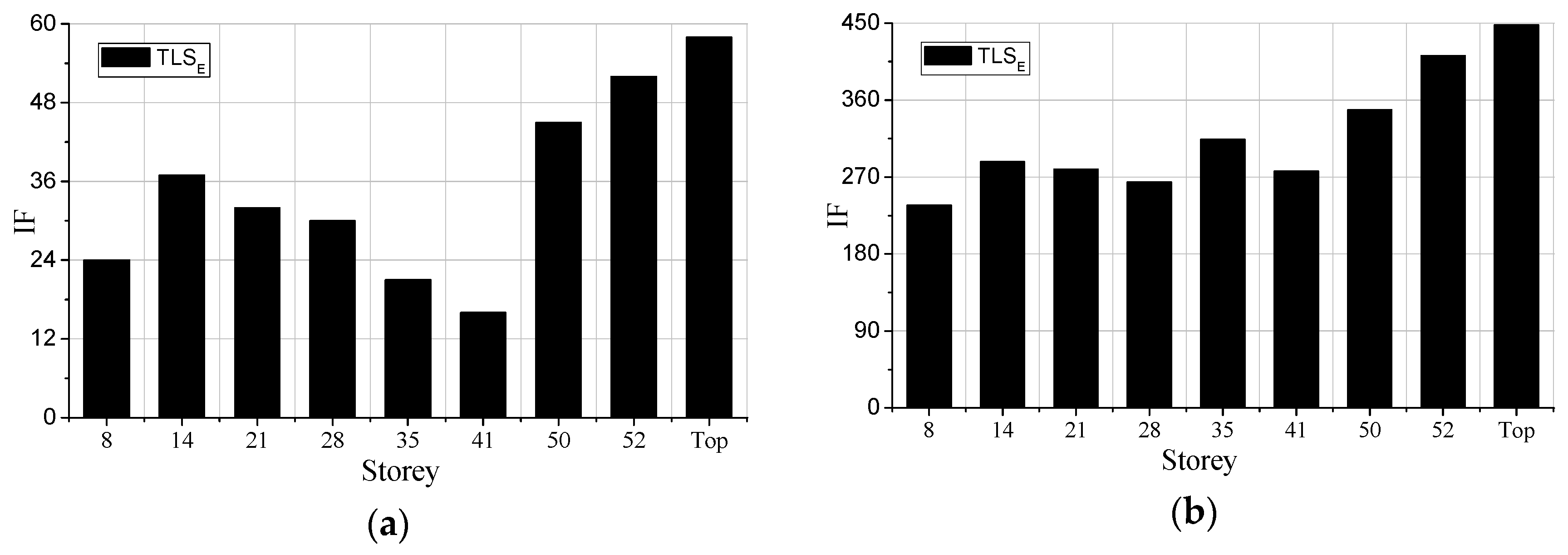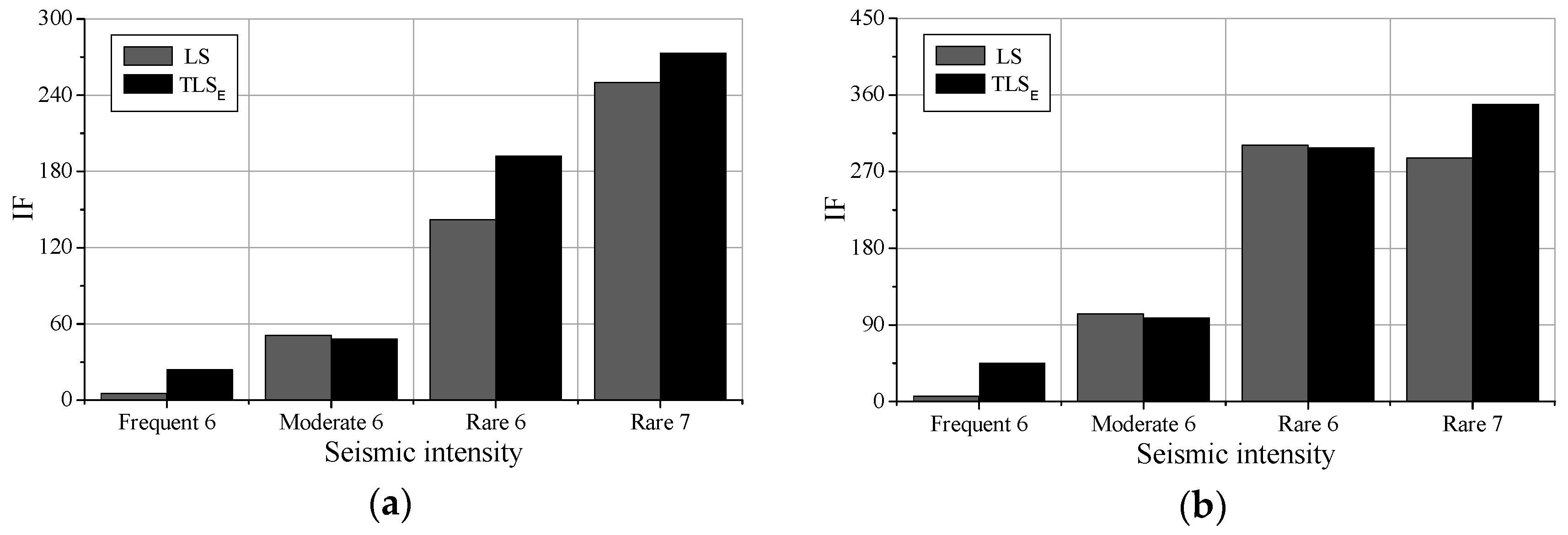1. Introduction
Civil structures are subject to many adverse factors [
1,
2,
3,
4] such as corrosion, aging, over-capacity loads, and may occasionally experience natural disasters such as earthquakes and hurricanes, and even extreme manmade events including vehicle-structure collision and explosion, causing structural damage to different degrees. In recent years, structural damage detection and identification have received much attention and different approaches have been developed [
5,
6]. For example, the sensor-based approaches can offer detailed information about local damage [
7]. Vision and thermal-image based methods can present structural surface damage [
8]. Vibration-based approaches are effective in detecting the damage in the entire structures [
9].
Vibration-based approaches have been widely applied to identify various types of damage in real and laboratory structures owing to their noninvasive characteristics [
10]. For example, Gul [
11] investigated the different damage detection methods for global condition assessment of structures based on vibration data. Morita et al. Datteo et al. [
12] identified the vibration responses of a real structure in Italy under operational conditions. Though various vibration-based methods, such as time-series analysis, wavelet analysis, and neural network, [
10], the statistical time-series methods form an important, rapidly evolving category. Fassois and Sakellariou [
13] summarized the principles and techniques of time-series methods for fault detection, identification, and estimation in vibrating structures. The time-series methods are originated in statistics and refer to a time-ordered sequence of random (stochastic) scalar or vector observations. These methods appear promising as they tend to be more accessible and less expensive than many other alternatives. The process of time-series methods involves the observation of a structure over time using periodical measurements, the extraction of damage sensitive quantities (features) from these measurements, and the statistical analysis of these quantities in order to determine the current structural state [
14].
A widely used time series method is the Auto-Regressive (AR) model [
15]. The AR model tries to account for the correlations between the current time parameter with the predecessors in time series, where the output variable depends linearly on its previous values and a stochastic term [
16]. From the perspective of a structural engineer, a structure can be assumed as a system that contains segments such as mass, damping, and stiffness. Therefore, the AR model parameters of a structure always stay the same. When the structure is damaged, the AR parameters of these models change accordingly and become different from those in the undamaged stage. Hence the changes of AR parameters can reflect the structural inner damage. Among all the possible strategies for AR modeling, the use of classical AR models is widespread. Basically, this model assumes that there are only errors in the current observations, and the noise variance is assumed as known, for example, the Gaussian white noise. The AR parameters are most commonly estimated by the least-squares (LS) method, and have been investigated in a number of studies [
15]. Methods such as Mahalanobis Squared Distance [
17], Yule-Walker equations [
18] and the maximum-likelihood method [
19] have also been adopted to solve the AR model.
Since the AR data are determined from measurements, there may be noises not only in the current observations but also in the predecessors. Hence, the classical AR model would be, inaccurately [
20]. The biases of the classical AR model are proved in some researches [
21,
22]. For example, one of the methods compensates for the LS estimation by computing its asymptotic bias to obtain a consistent identification procedure [
23]. If the AR model takes the errors of the previous data into consideration, it can be represented as the errors-in-variance (EIV) model [
24]. In the field of geodetic survey, this model has already received extensive attention. The algorithms are used to numerically obtain the total least-square (TLS) solution and the applications of EIV model have been actively investigated [
25]. Therefore, the existed studies of the EIV model can be applied in the field of structural damage identification.
This paper is aiming at introducing an AR model which contains additive white noises, and applying a new identification method based on the theory of the partial EIV model to solve the AR model with additive noises. This method allows the consideration of both errors in the current and past observations. The identification method is also applied in a real case. The rest of the paper is structured as follows. In
Section 2, the AR models and EIV model are briefly introduced, and then an AR model with additive noises is developed. In
Section 3, the theories of LS and TLS are introduced; a TLS solution proposed by Yun et al. [
26] for solving the partial EIV model is firstly used to solve the AR model with additive noises; and a more common solution for the partial EIV model considering the possible correlations between the observed vector and design matrix is also proposed. A damage indicator is developed to represent the severity of the damage through a mathematical simulation. In
Section 4, the performance of three methods are studied by identifying the damage of a finite element simulation case. Results show that the extended solution considering the possible correlations between the observed vector and design matrix can not only identify the structural damage and degrees but also perform better than the TLS solution proposed by Yun et al. [
26] and the LS solution for classical AR model. In the application of the proposed method in the real case, the experimental data of a shaking table test are used to identify the damage of the model of different seismic levels in
Section 5.
2. AR Model with Additive Noises
The classical AR model is introduced in this section followed by the introduction of the LS solution for the typical AR model. Due to the disadvantages of the LS solution, the AR model with additive noise is developed.
A classical AR model of order
is described by
where
is the discrete-time signal of acceleration responses in this paper;
is random noise of
;
is the unknown order of this model and varies from 0 to
; and
is the unknown AR coefficient to be estimated. In a real case, where a civil structure works under operational conditions, noise is usually assumed as Gaussian white noise with a zero-mean and unknown variance, hence the random noise
is assumed as the Gaussian white noise in this paper.
In fact, the left term
of the model can be regarded as the sum of two terms in the right. The first term is contributed by
to
with unknown coefficients respectively, while the second term represents the noise affection. Denoting
,
, and
, the AR model can be represented as:
where
is the error corresponding to
. As mentioned before, all of the
are observed. Therefore, both the
and matrix
A contain errors in real cases. However, the corresponding errors to
A are omitted unreasonably in the general AR model. Thus, errors should be added to
A in Equation (2). Meanwhile, taking current observed values and all the errors of previously observed values in consideration, the AR model can be rewritten as,
That is,
where
is also assumed as Gaussian white noise. Equation (4) is subject to
where
and
are diagonal weight matrices of
and
.
, which is the vector of putting the elements of
into a vector one column after another.
,
. In a special case where the matrix
contains no errors
, the model becomes the classical AR model with only noises
. By solving the parameter
of Equation (4), the AR coefficients can be obtained.
Actually, Equation (4) is the EIV model. As mentioned in the introduction, finding out the solution of the EIV model is quite popular in the field of geodetic survey and various methods have already been developed. Hence the parameters of this AR model with additive noises can be estimated based on the comprehensive literature studies of the EIV model in the next section.
3. TLS Adjustment for the AR Model with Additive Noises
After introducing the AR model with additive noises in
Section 2, this section introduces the solutions to the EIV model. Furthermore, the algorithm to estimate the parameters in the AR model with additive noises is presented.
3.1. LS and TLS Method for EIV Model
The simplest approximate approach to estimate unknown vector
is the LS method. The LS method is processed by Lagrange Extremum Method. The estimation results are shown as:
Estimated residual and scalar are:
However, as noted previously, this method ignores the errors in the design matrix
as if it is deterministic, which may lead bias to the results. To solve this problem, TLS method is proposed to handle both the random observational vector and the random elements in
. The TLS method takes the
in Equation (4) into consideration, which is surely more rigorous than the LS method. After the first invention of TLS, it is widely used in various fields, and many algorithms such as ordinary TLS and weighted TLS, are used to estimate parameters in the EIV model. Golub and van [
27] solved the EIV model by minimizing the Frobenius norm of the corrections of both A and y in 1980, named SVD method. Then, a lot of researches after the SVD method are proposed [
28]. The method is shown as follows.
Firstly, given the estimation criterion function of TLS:
;
; and both
and
are positive.
donates the Frobenius norm of
. Then the minimization object can be solved by computing the singular value decomposition of
:
where
is the positive diagonal matrix arranged in decreasing order; and
. When
, there is a unique solution:
However, Xu et al. [
28] pointed out that Pearson’s solution is still a kind of LS method. Furthermore, the SVD method was just a TLS solution based on numerical approximation and was not a real TLS. Therefore, the application of the SVD method is limited even though it is easy.
3.2. TLS Solution for the Partial EIV Model
Xu et al. [
28,
29] extended the EIV model to a more general one named partial EIV model and proposed an algorithm to solve it. In this model, not all the elements of A are random. The partial EIV model is shown as follows:
where
;
is a
deterministic constant vector whose elements consist of non-random elements of
;
stands for the Kronecker Product.
is a
vector with entries of independent random elements in the design matrix, and it is the true value of
;
is a given
matrix that depends on the number of random elements in
;
is a vector representing the random part. The solution for this partial EIV model has also been proposed.
Firstly, assume that
and
are stochastically independent,
Then the TLS solution to the partial EIV model is proposed as [
28],
where
,
. And
,
,
,
are
matrices, for
, and they are be respectively given by
Furthermore, Yun et al. [
26] proposed an alternative solution to the partial EIV model. The solution is shown as follows:
where
. The final solution can be obtained by iteration. Yun et al. [
26] illustrated that the new one could be more compact and direct than the formula proposed by Xu [
28], which is easier and can be processed much more quickly if the number of independent random elements of the design matrix
is significantly larger than that of the measurements. It is clear that the EIV model in Equations (16) and (17) and the solutions in Equations (31) and (32) are more general.
However, in the AR model with additive noises, there should be the same elements in
and
, leading to the same elements existed in
and
. Therefore,
and
may be not stochastically independent. It cannot be simply assumed that
, which means the TLS above cannot be used. Here the errors of
in the
are not regarded as the same with the errors of
in the
,
. That is,
is not always the same with
, then the method proposed by Yun et al. [
26] can be applied to solve the AR model with noises. Even though
should be equal to
in real cases, the real values of the errors in
are always unknown. Therefore, both
and
have chances to be closer to real errors. Based on this uncertainty, it is more compatible to suppose that
and
are not the same and estimate them independently, than ignoring the errors in matrix
immediately.
As mentioned before, Equation (4) is a special case of the partial EIV model. When
,
, Equation (16) turns to Equation (4), which is,
Considering that all the observations in AR model are obtained in the same condition and by the same measuring instrument, the weight of each obtained output time-series signal can be assumed to be the same. Therefore, the diagonal weight matrix
can be simplified as a unit matrix in the AR model in this paper. The TLS parameter estimation steps of the AR model with additive noises are shown as follows [
26,
28]:
Given and , , ;
Initialize
Compute by Equation (31);
Compute by Equation (32) based on the obtained in step 3.
Give a predetermined tolerable errors value. Terminate the process if errors between and are within the given value. Otherwise, go to Step 3.
3.3. TLS Solution for the AR Model with Additive Noises
As mentioned above,
may be not equal to zero, thus the TLS solution for the partial EIV model can be extended to a more general one which does not care about the correlations between
and
. Firstly, rewrite the EIV model as,
where
, and
is a
vector which consists of all the real random elements in the vector
and design matrix
A.
is an unit matrix with size of
. The objective function is then modeled as,
where
, and
is the weight matrix of
. By differentiating
in Equation (26) with respect to
, and
, and setting all these partial derivatives to zero, we can obtain the following equations:
Finally, the general solution can be obtained as,
The steps of this TLS algorithm for the partial EIV model are shown as follows:
Given A and , denote and
Calculate
Compute the LS solution
Initialize
Obtain using Equations (30)–(32) and renew
Provide a predetermined tolerable error value. Terminate the process, if the errors between and are within the given value. Otherwise, go to Step 3 and repeat.
The AIC criterion for the AR model is used in this paper to find out the optimal order
of the AR model, formulated as [
30]:
where
is the estimated variance of residual errors of order
n.
The following step concentrates on proving the effectiveness of the TLS method proposed by Yun et al. [
26] in the parameter estimation of AR model with additive noises.
3.4. Performance Analysis
In this section, a numerical simulation is conducted to study the performance of the two estimating method proposed by Yun et al. [
26] in
Section 3.2 and extended method in
Section 3.3. The estimation results of these two methods under different noises conditions are analyzed carefully, and the comparisons between classical AR model and these two solutions are demonstrated.
Consider the following 4th-order AR model [
21],
where
is the white noise with the unknown variance, and
. The number of samples is limited to 300, and the signal-to-noise ratio (SNR) is different when applying the noises to the AR model [
20].
For each run, the Gaussian white noise is added by the function
awgn in the MATLAB to all of the output data
. Six conditions of the SNR, 60 dB, 50 dB, 40 dB, 30 dB, 20 dB, and 10 dB, are respectively added to the true value, and the noise series are the same in the same noise condition. The TLS
p represents the solution in
Section 3.2, and the TLS
E represents the solution in
Section 3.3.
When
, the AIC meets its minimum value. When the AR model is noise-free, all the identification results are equal to the real values
. Other results are summarized in
Table 1. It can be seen that when the SNR = 60 dB, the solutions of the LS, the TLS
p and the TLS
E estimation are nearly the same and quite close to the real value, indicating all the methods perform well in this condition. However, the SNR rises as the differences between these two methods increasing. When the SNR is 30 dB, the results of the TLS
E method approximate the true value, while both the LS and the TLS
p method differ much. When the SNR is 10 dB, the same performances can be found. It is argued that the TLS
E solution for the AR model with additive noises can be more accurate. Hence, it may be concluded that even though all the three methods can be used for parameter estimation of the AR model with additive noises, the TLS
E estimation method can perform better than the other two. This advantage can be obtained especially in the presence of strong noise in the AR model.
3.5. Damage Indicator
After the unknown parameter of the AR model is obtained, a damage indicator needs to be defined to assess the damage level of the structure. The difference between in the healthy conditions and that in damage conditions cannot be measured just by visual inspection simply, especially when there is a lot of elements in . In this paper, the ratio between Euclidean distance of the undamaged and the damaged is used to indicate the structural damage. Steps are clarified as follows.
Divide the obtained response acceleration data before damage into two parts, i.e., part and part , where serves as the baseline data while serves as the unknown inspection data to be estimated in the healthy state of the structure.
Estimate
and
. The square of Euclidean distance between
and
is determined as,
Estimate the
of the
i-th response acceleration data after damage. The Euclidean distance between
and
is calculated as,
Finally, the damage indicator is calculated as the ratio of
and
,
It is clear that if the data to be estimated are associated with the undamaged structure, the IF is close to 1. Otherwise, the changes of the AR parameters are increasing while the damage rising. Therefore, the IF values are rising as the damage level of the structure is increasing.
Assuming that each
are obtained due to structural damage instead of errors, each estimation result represents a condition of the system. For example, assuming that when SNR = 20 dB, the TLS
p solution
in
Table 2 is estimated by the output signals of damaged structures in one of the six different conditions by the TLS
p method. Then the damage levels of structures should be increasing with the increase of the SNR. The IFs of the example in
Table 1 are shown in
Table 2.
It can be seen that the IFs are rising as the SNR is increasing, reflecting both the effectiveness of the damage indicator and all the three damage identification methods. As for the same SNR, the IFs based on the TLSE solution for the AR model with additive noises are always smaller than those on TLSE solution for the AR model with additive noises and the LS solution for the classical AR model. For example, when the SNR = 10 dB, the IFs of the LS solution are about 90 times and 134 times as large as the IFs of the TLSE solution. However, when comparing the TLSp solution with the LS solution, in some cases the TLSp solution may be better while in other cases worse than the LS solution. Therefore, both the LS solution, TLSp solution and the TLSE solution for the AR model with additive noises can be effective in this mathematical simulation. However, the former one is not stable enough, and the TLSE solution not only performs the best but also can always obtain accurate results, even in the presence of high amounts of noise.
4. Finite Element Simulation
The performance of the TLSE solution for the AR model with additive noises is studied by a finite element simulation in this part. The acceleration observations in different damage conditions are used as the time-series signal in the AR model. A simply supported beam with constant cross-section is modeled by the finite element software SAP2000. The size of the model is shown in
Figure 1, with a density of 7850 kg/m
3 and elastic modulus of
pa. The Gaussian white noise is applied to the beam, and the obtained accelerations of each testing point serve as the response signals in the AR model. Assume that element 4 is damaged into different degrees in four conditions, which are listed in
Table 3. The damage of the beam is simulated by reducing the bending stiffness of specific elements in different degrees.
The accelerations of the testing points before damage are used as the undamaged condition.
Table 4 lists the first to the fourth structural frequencies under different conditions. It can be seen that when a damage degree of 10% occurs in the element 1, the first order frequency is 9.32 Hz, which is larger than the other conditions, but smaller than the undamaged condition 9.36 Hz. It may be inferred that as for the first-order frequency, the damage of the beam becomes larger as the testing conditions number increasing.
The first order of the frequency in the undamaged stage is also calculated by frequency calculation formula in Ref. [
31]. Firstly, the first order circular frequency can be calculated as,
where
is mass;
is the elastic modulus;
is the inertia moment. Hence, the engineering frequency is,
The
and
are nearly the same with the simulation results. Since 9.36 Hz is quite close to 9.37 Hz, so the FEM outputs can be assumed to be reasonable and can be used for further study. According to the sampling theorem, sampling frequency is set as 500 Hz, and the total testing time 25 s, respectively.
Figure 2 shows the power spectral density (PSD) of the output accelerations of testing point 5. It can be seen that the first order frequency falls into 9–10 Hz in
Figure 2a while in
Figure 2b the peak is located between 8–9 Hz. The third order frequency of the model beam is about 80 Hz, which can also be inferred in
Figure 2a,b. Since the testing point 5 is located in the middle of the beam, there should be no bulges appeared near the second order frequency, which can also be found in the figures.
After the accelerations of measuring points under different conditions are obtained, the damage indicator presented in
Section 3 will be calculated through MATLAB.
4.1. Identification Results in the Condition of No Noises
Parts of the damage identification results are shown in
Figure 3. It can be concluded in
Figure 3a that as the damage of element 4 is increasing, the IFs are rising, indicating that the proposed damage detection method can identify the damage degrees in the beam. It can be concluded in
Figure 3b that the IFs of point 3 and point 4 are larger than other parts, which means that there is damage in element4. Therefore, the proposed method can also be used for detecting damage locations in structures. However, as for testing points near the undamaged elements, such as point 2, point 3, the IFs are not equal to one. Due to the limited mesh in SAP2000, the damage of element 4 influences its adjacent elements, causing the IFs dropping from testing point 4 to 9. Furthermore, it is clear that the IFs of point 3 and 4, 2and 5, 1 and 7 are not the same, and the points on the left part of element 4 are always larger than the points on the right in the beam, reflecting that the influences of the damage of element 4 may be larger on the left.
In conclusion, the damage identification method based on the TLSE solution and AR model with additive noises can not only detect damage degrees but also damage locations.
4.2. Identification Results in the Condition of Noises
In order to study the anti-noises ability of the proposed damage identification method, noises are added to the output signal to simulate the observation errors. Firstly, the accelerations with no noises are identified by the classical AR model and LS solution, which are regarded as the relative standard solution. Then, the accelerations with 30dB noises are identified by the TLS
E solution and AR model with additive noises. At last, the accelerations with 30dB noises are also identified by the classical AR model and LS solution for comparing the performances of these two methods. The property density function (PDF) diagrams for the output signal with noises of point 3 is shown in
Figure 4.
After analyzing all the identification results, it can be concluded that the IF values obtained by the TLS
E solution are increasing as the damage of element 4 increasing, reflecting that the damage identification method based on TLS
E solution can detect damage degrees. What’s more, IFs obtained by TLS
E solution are always closer to the LS solutions in the no noises condition, reflecting that the TLS
E solution can identify the damage of structures more accurate when the noises level is 30dB. Parts of results of the testing points are shown in
Figure 5. The damage identification results along the beam in condition 4 are shown in
Figure 6. IFs of point 3 and 4 obtained by TLS
E solution are much bigger than others, reflecting its effectiveness in detecting damage locations even when the observations have noises. However, results obtained by LS are quite different from that of no noises. And the damage location is not quite remarkable, for instance, IFs of point 3 and 4 are not much bigger than the IFs of others, and IF of point 6 is even larger than the IF of point 5. It can be concluded that the LS solution contains bias while the observations have unneglectable noises.
In conclusion, this finite element simulation can prove that: (1) The IF values obtained by the proposed method are always rising while the damage degrees of the simulated elements are rising. (2) The IFs near the damaged elements are much larger than other IFs. (3) Compared with classical AR model and its LS solution, the IFs obtained by the proposed method in the noisy conditions are always closer to the IFs obtained in the no-noises condition. Therefore, damage identification method based on TLSE solution and AR model with additive noises can detect both structural damage levels and the structural damage distribution, and this proposed method can behave better than the method based on the classical AR model and LS solution.
6. Conclusions
An Auto-Regressive (AR) model with consideration of additive noises as well as its total least square solution has been presented for structural damage identification in this paper. The total least square method is based on the partial errors-in-variance (EIV) model. The AR model with additive noises takes the errors of all the observed data into consideration. After comparing the proposed method with the classical AR model and least square (LS) solution in a mathematical simulation and a finite element simulation, the advantages of the new identification method have been demonstrated. A damage identification indicator has also been presented to measure the AR parameter differences between healthy stage and the damaged stage, reflecting the damage degrees. Finally, the proposed method has been applied to the acceleration responses of a shaking table test. The proposed method can estimate both the damage level and damage distribution of structures. Hence, the damage estimation method exhibits its usefulness in engineering applications.
This study makes contributes significantly to the literature because the proposed method can reduce the identification errors, and behave well even in high amount of noises, which is more practical than classical identification methods based on the AR models. Furthermore, the achievements in the field of the geodetic surveys are first systematically introduced to the field of vibration-based structural damage identification, which could promote the combination of these two fields to benefit further studies in the field of structural health monitoring.
The simulated beam in
Section 4 may be improved to a more real one. Future works may focus on the development of more efficient de-noise methods for structural damage identification. A more general solution of the TLS
p for the AR model with additive noises can be studied when considering
, especially the weighted TLS solution for putting different kinds of observations together to reduce errors. Other estimation methods and criterion such as BIC, FPF for the EIV model can be introduced into the field of structural health monitoring.

